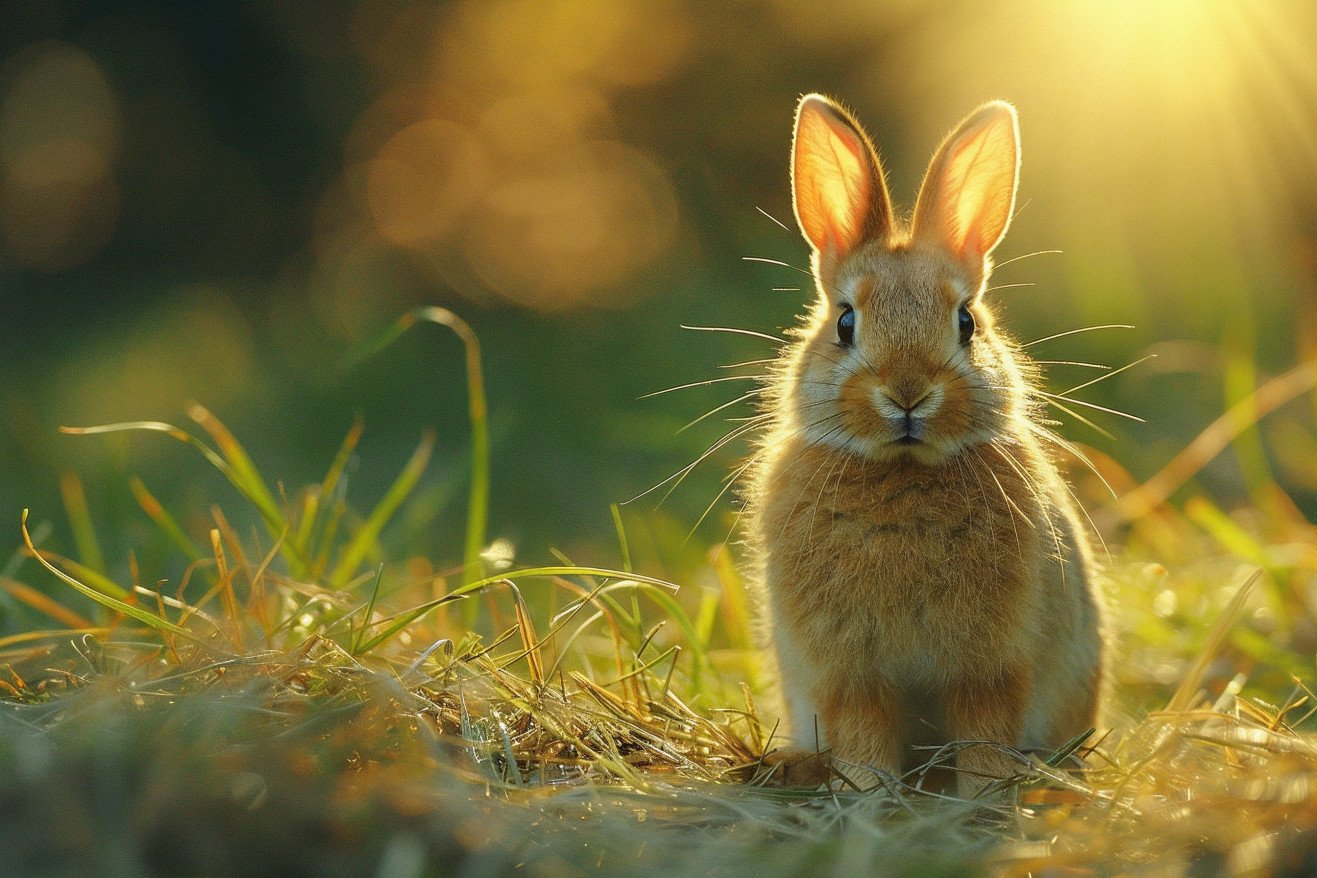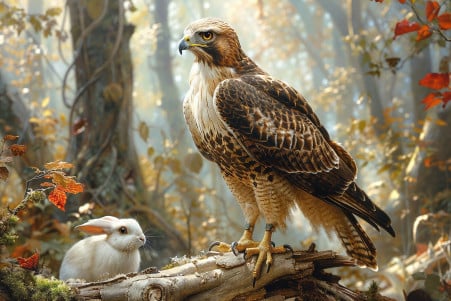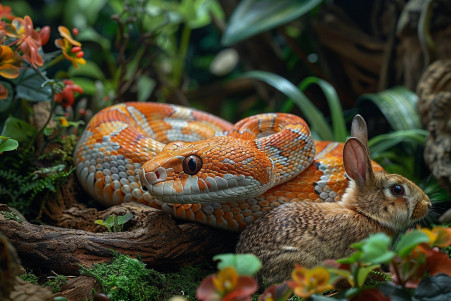What Predators Eat Rabbits? A Look at Their Natural Predators
21 February 2024 • Updated 20 February 2024

Rabbits are often thought of as quick and nimble, but what predators are actually chasing them in the wild? Natural predators of rabbits include foxes, coyotes, eagles, hawks, owls, snakes, wolves, badgers, and domestic cats. These predators have evolved a range of hunting skills to capture rabbits, and this is important because rabbits are a key part of their ecosystems.
As we continue our exploration of the ins and outs of the food web, we will take a deep dive into ecological and behavioral research to learn about the many predators that hunt rabbits and the ways in which they hunt.
We will also learn about the important role rabbits have in keeping the environment in balance and how their defenses against predators help them stay alive. Let’s learn about the complex relationship between predator and prey that ensures rabbits can survive in the wild.
What predators eat rabbits?
The Predators Lurking in the Shadows: A Look at Rabbits’ Natural Foes
A wide range of predators around the world use different hunting methods to keep rabbit populations in check. Foxes and coyotes, both of which are found throughout North America, use their sharp senses and quick reflexes to hunt rabbits in natural and urban edge environments. Meanwhile, stoats and ferrets, which have excellent night vision and are extremely agile, have become skilled rabbit hunters in Europe and Asia.
Meanwhile, birds of prey, including hawks, eagles, and owls, fly over rabbit habitats around the world, using their powerful talons and the element of surprise to swoop down and grab these small mammals. Snakes, meanwhile, use stealth to sneak up on rabbits, with the largest species, such as boas, being able to swallow adult rabbits whole.
Rabbits also face predation from domestic animals. While neither cats nor dogs rely on rabbits for food, both are known to chase and kill them. This has been observed in rural and urban areas where domesticated animals and wild rabbits live in close proximity.
From the dense forests of North America to the arid scrublands of Australia, these predators’ habitats overlap with those of rabbits, demonstrating a worldwide predator-prey relationship. This complex relationship is essential to the ecological role of rabbit predation, helping to control populations and influence biodiversity.
The Balancing Act: Predators and the Regulation of Rabbit Populations
Predators are essential to keeping rabbit populations in check and preventing them from growing out of control. As one review in Mammal Review notes, predators have the ability to regulate rabbit populations, especially when they have been reduced by other means, such as disease. In the absence of predators, rabbit populations can explode, demonstrating the necessity of predators in keeping ecosystems in balance.
When predators are removed, rabbit populations can grow to the point of causing ecological imbalances. For example, the introduction of myxomatosis led to a significant decline in rabbit populations, which in turn caused a major shift in agricultural practices and impacted native plants and animals. Predators are also important for the conservation of biodiversity, and their loss can have widespread impacts.
In addition, a study published in PMC points out that predators have an impact on rabbits’ spatial behavior and habitat selection. Predator pressure is a key factor in rabbit population regulation and acts as a limiting factor, especially when rabbit populations are low.
The relationship between rabbits and their predators is essential to the health of ecosystems, and the survival of each species is dependent on the strategies of the other in the ongoing battle for survival.
The Art of Avoidance: How Rabbits Escape Predators
Rabbits may be prey animals, but that doesn’t mean they’re defenseless. In fact, rabbits have a number of ways to avoid being caught by predators. According to Bunny Lady, the most important of these is running away, which rabbits are able to do at speeds of up to 30 miles per hour.
Rabbits also have an impressive array of senses that help them avoid predators. Bunny Horde explains that rabbits have almost 360-degree vision and can hear frequencies between 360 and 42,000 hertz.
In addition to these sensory adaptations, Amy Pratt explains that rabbits have a number of physical adaptations that help them avoid predators. For example, rabbits’ strong back legs allow them to kick with a lot of force, and their sharp claws and teeth make them dangerous to potential predators.
In addition, rabbits are able to use their knowledge of their environment to avoid predators. For example, they can use their speed to perform evasive maneuvers like zigzagging and burrowing, which is especially effective at protecting them from both aerial and ground predators.
Rabbits’ social adaptations can also help them avoid predators. For example, the way rabbit groups are structured can help draw a predator’s attention away from an individual rabbit, increasing that rabbit’s chances of escape.
While these adaptations can help rabbits avoid many predators, they don’t make rabbits immune to predation. As a result, the balance between the number of rabbits that are able to avoid predators and the number that are eaten by them is always in flux.
The Importance of Protecting Rabbits
The concern for the conservation status of rabbits is a global one, and it’s not just because of the many predators that rabbits face. According to Britannica, there are 29 species in the family Leporidae, and each one is facing its own challenges.
For example, the volcano rabbit and the riverine rabbit are both critically endangered due to habitat loss and low population numbers. Similarly, the Amami rabbit and the Sumatran rabbit are both critically endangered due to human activities and the introduction of non-native predators.
Habitat loss, Rabbit Haemorrhagic Disease and Myxomatosis, and climate change are all major threats to rabbits. Oftentimes, these threats make the natural threat of predation even worse, leading to a cumulative effect on rabbit populations. According to the People’s Trust for Endangered Species, while changes in farming and predator control in Britain have led to an increase in rabbit populations, diseases have historically wiped out these populations.
Conservation efforts are focused on protecting habitats, managing diseases, and reducing human activities. However, the People’s Trust for Endangered Species notes that the global conservation status of rabbits is Near Threatened. While human activities have led to the endangerment of rabbits, our actions are also necessary for their conservation, which shows the delicate balance between these animals and the human responsibility to their environments.
Walking the Line Between Life and Death: How Rabbits Balance Foraging and Avoiding Predators
Rabbits face a constant struggle between the need to forage for food and the danger of being eaten by a predator. This means that the way they eat can directly impact their chances of being eaten.
For example, the thicker the brush, the more protection they have from predators, but the brush can also limit their ability to see and escape. In BMC Ecology, scientists describe how European rabbits on the Kerguelen archipelago adjust their behavior based on the level of danger they perceive, including increasing their vigilance and changing their choice of habitats.
But rabbits’ interactions with other rabbits are also important to their survival. In a study in PMC, researchers show that European rabbits form social groups in the wild that are structured in a way that likely helps them secure resources and reduce their chances of being eaten by a predator.
The way that individual and group behaviors change in response to the presence of predators shows that rabbits have a sophisticated way of assessing risk and making decisions.
In a study in Wildlife Biology, researchers show that the structure of the environment and the amount of cover it provides have a big impact on rabbit foraging behavior because rabbits have to balance the need to eat with the need to avoid predators.
When you consider the many factors that rabbits have to balance in order to survive, it’s easy to see that their lives depend on these daily decisions. This is a powerful reminder of the delicate balance of nature and the importance of ongoing research and conservation.
Pulling Apart the Web of Ecosystem Dynamics: The Story of the Rabbit
The complex relationships between rabbits and their predators show just how many sides there are to the story of these important animals in the balance of nature. As we have seen, rabbits are the prey of many different animals, from foxes and coyotes to raptors and even domestic pets, and each of these predators has its own way of hunting rabbits.
The impact of rabbit predation on the environment is due to the way it controls rabbit populations, which in turn affects the health of the ecosystems rabbits live in.
To avoid their many predators, rabbits have evolved a wide range of adaptations, from their speed and agility to their senses, burrowing behavior, and social lives. But the threats to their survival, from habitat destruction to disease and climate change, go beyond the natural predators they face, and it’s important that we work to protect them with more knowledge and understanding.
As we wrap up our look at the lives of rabbits and the animals that prey on them, it’s important to remember the importance of their survival. Each strand in the web of ecosystem dynamics adds to our understanding of the world around us. With more study and conservation, we can help protect rabbits and the environments they live in, making sure that the ecosystems they are a part of continue to thrive.


